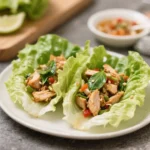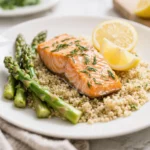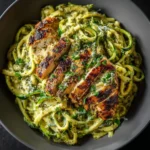Thai Basil Chicken Lettuce Wraps (No Pork) – A Flavorful, Light, and Aromatic Dish
Delight your taste buds with this vibrant and healthy Thai Basil Chicken Lettuce Wraps recipe—crafted without pork for those who prefer poultry or are avoiding red meat. This aromatic stir-fry combines tender chicken, fragrant Thai basil, crisp vegetables, and a savory-sweet-spicy sauce, all wrapped in fresh lettuce cups for a light yet satisfying meal. Perfect for low-carb, keto, or gluten-free diets, these wraps bring the bold essence of Thai street food straight to your kitchen with ease and elegance.
The History
Thai Basil Chicken, known as Kai Pad Krapow (ไก่ผัดกระเพรา) in Thailand, is one of the most beloved dishes in Thai cuisine. Traditionally served with minced pork or chicken, a fried egg on top, and steamed jasmine rice, it originated as a quick, flavorful street food dish found throughout Bangkok and rural markets alike. The use of holy basil (kaphrao) gives the dish its distinctive peppery aroma, though sweet basil or Thai basil is often used outside Thailand due to availability. Over time, regional adaptations have emerged, including versions that omit pork for religious, dietary, or personal reasons. The lettuce wrap variation is a modern, health-conscious twist popularized in Western wellness circles, transforming a traditionally carb-heavy meal into a refreshing, low-calorie alternative while preserving the complex flavor profile of the original.
Ingredients Breakdown
The magic of Thai Basil Chicken Lettuce Wraps lies in its balance of textures and flavors—umami-rich, slightly sweet, spicy, and herbaceous. Here’s a detailed look at each component:
- Chicken Breast or Thighs: Boneless, skinless chicken breast offers a leaner option, while thighs provide more moisture and richness. Thinly sliced, they cook quickly and absorb the sauce beautifully.
- Thai Basil: Essential for authenticity. Look for dark green, pointed leaves with a clove-like fragrance. If unavailable, substitute with Italian basil mixed with a few mint leaves for depth.
- Fresh Red Chilies or Bird’s Eye Chilies: These add heat. Adjust quantity based on spice tolerance. Deseed for milder flavor.
- Garlic: Minced finely to distribute pungent aroma throughout the dish.
- Shallots or Yellow Onion: Adds sweetness and complexity when sautéed.
- Lettuce (Butter Lettuce, Romaine, or Iceberg): Used as edible cups. Choose large, sturdy leaves that hold filling without tearing.
- Vegetable Oil or Coconut Oil: High smoke point oil ideal for high-heat stir-frying.
- Fish Sauce: The backbone of umami. Use premium fish sauce for balanced saltiness without excessive funk.
- Low-Sodium Soy Sauce or Tamari (Gluten-Free Option): Complements fish sauce with deeper color and savory notes.
- Oyster Sauce (Vegetarian Oyster Sauce Optional): Adds body and subtle sweetness. Mushroom-based versions work well for vegetarians.
- Brown Sugar or Coconut Sugar: Balances acidity and salt; enhances caramelization.
- Water or Vegetable Broth: Thins the sauce slightly to coat ingredients evenly.
- Lime Wedges (for serving): Brightens the rich flavors with citrus zest.
- Toasted Sesame Seeds or Crushed Peanuts (optional garnish): Adds nuttiness and crunch.
Step-by-Step Recipe
- Prepare Ingredients: Slice 1 lb (450g) chicken into thin strips. Mince 4 cloves garlic, 1 small shallot, and 1–2 red chilies (adjust to taste). Wash and dry 1 head of butter lettuce, separating large outer leaves for wrapping. Chop 1 cup fresh Thai basil leaves, keeping them separate until the final step.
- Make the Sauce: In a small bowl, whisk together 2 tbsp fish sauce, 1 tbsp soy sauce (or tamari), 1 tbsp oyster sauce, 1 tsp brown sugar, and 2 tbsp water. Set aside.
- Heat the Wok or Skillet: Place a wok or large non-stick skillet over high heat. Add 1½ tbsp vegetable oil and swirl to coat.
- Sauté Aromatics: Add garlic, shallot, and chili. Stir-fry for 30–45 seconds until fragrant but not burnt.
- Cook the Chicken: Add chicken strips in a single layer. Sear undisturbed for 1 minute, then stir-fry for 3–4 minutes until cooked through and lightly browned.
- Add the Sauce: Pour the prepared sauce over the chicken. Stir well and cook for another 1–2 minutes, allowing the sauce to reduce slightly and cling to the meat.
- Incorporate Basil: Remove from heat and immediately stir in the Thai basil leaves. The residual heat will wilt them perfectly, releasing their essential oils.
- Taste and Adjust: Sample the mixture. Add a splash more fish sauce for saltiness, lime juice for acidity, or sugar for sweetness if needed.
- Assemble Lettuce Wraps: Lay out lettuce cups on a platter. Spoon the chicken mixture into each cup. Garnish with sesame seeds or crushed peanuts if desired.
- Serve Immediately: Accompany with lime wedges and extra chilies on the side for customization.
Tips
- High Heat is Key: Stir-frying over high heat ensures the chicken sears quickly, locking in juices and creating that authentic “wok hei” (breath of the wok) flavor.
- Don’t Overcook Basil: Add it off-heat to preserve its vibrant color and aromatic freshness.
- Dry Lettuce Leaves Thoroughly: Wet leaves can make the wraps soggy. Pat them dry with a clean towel.
- Prep Everything Ahead: Stir-fries move fast. Have all ingredients chopped, measured, and within reach before heating the pan.
- Use a Carbon Steel Wok or Heavy Skillet: Ensures even heat distribution and better browning.
- Double the Sauce for Leftovers: The dish reheats well and tastes great over cauliflower rice or quinoa.
- Add Vegetables: For extra nutrition, include thinly sliced bell peppers, zucchini, or mushrooms during the stir-fry stage.
Variations and Customizations
- Vegetarian/Vegan Version: Replace chicken with crumbled tofu, tempeh, or plant-based ground “meat.” Use vegan fish sauce and mushroom-based oyster sauce.
- Seafood Twist: Substitute chicken with chopped shrimp or scallops. Cook just until opaque to avoid overcooking.
- Extra Heat: Add a dash of sriracha or chili garlic paste to the sauce, or serve with sliced fresh bird’s eye chilies on the side.
- Herb Variations: Mix in cilantro or mint with the basil for a brighter herbal note.
- Nut-Free Option: Skip peanut garnish; use toasted sunflower seeds instead.
- Low-Sodium Diet: Use reduced-sodium soy sauce and fish sauce, and increase lime juice or a touch of apple cider vinegar for tang.
- Pineapple Addition: Toss in diced fresh pineapple for a sweet-tropical contrast that pairs wonderfully with the spice.
Health Considerations and Nutritional Value
These Thai Basil Chicken Lettuce Wraps are naturally lower in carbohydrates and calories than traditional rice-based versions, making them suitable for various dietary lifestyles including keto, paleo, and low-FODMAP (with modifications).
Nutritional Highlights (per serving, approximately 3 wraps):
- Calories: ~220 kcal
- Protein: ~25g (supports muscle repair and satiety)
- Fat: ~10g (mostly unsaturated from healthy oils)
- Carbohydrates: ~8g (net carbs ~6g, primarily from vegetables and minimal sugar)
- Fiber: ~2g (from vegetables and herbs)
- Sodium: ~900mg (can be reduced by using low-sodium sauces)
Health Benefits:
- Rich in antioxidants from garlic, chilies, and basil.
- Chicken provides lean protein and essential B-vitamins like B6 and B12.
- Fish sauce contains trace minerals such as iodine and selenium.
- Lettuce contributes hydration and vitamin K.
- Chilies contain capsaicin, which may boost metabolism and reduce inflammation.
Note: Those with seafood allergies should avoid fish sauce or use a soy-based alternative. Individuals on blood thinners should monitor vitamin K intake from leafy greens.
Ingredients
- 1 lb (450g) boneless, skinless chicken breast or thighs, thinly sliced
- 1½ tbsp vegetable oil or coconut oil
- 4 cloves garlic, minced
- 1 small shallot or ¼ cup yellow onion, finely chopped
- 1–2 red chilies (such as Fresno or Thai bird’s eye), thinly sliced (seeds removed for less heat)
- 1 cup fresh Thai basil leaves (plus extra for garnish)
- 1 head butter lettuce, romaine, or iceberg, leaves separated and dried
- 2 tbsp fish sauce (or vegan alternative)
- 1 tbsp low-sodium soy sauce or tamari
- 1 tbsp oyster sauce (or vegetarian mushroom oyster sauce)
- 1 tsp brown sugar or coconut sugar
- 2 tbsp water or vegetable broth
- Lime wedges, for serving
- Optional garnishes: toasted sesame seeds, crushed peanuts, extra chilies
Directions
- Prepare all ingredients as listed. Keep the Thai basil separate until the end.
- In a small bowl, combine fish sauce, soy sauce, oyster sauce, brown sugar, and water. Mix well and set aside.
- Heat a wok or large skillet over high heat. Add oil and swirl to coat the surface.
- Add garlic, shallot, and chili. Stir-fry for 30–45 seconds until aromatic and sizzling.
- Add chicken in a single layer. Let sear for 1 minute, then stir-fry for 3–4 minutes until cooked through and lightly browned.
- Pour in the sauce mixture. Stir to coat the chicken evenly and cook for 1–2 minutes until slightly thickened.
- Remove from heat and immediately stir in the Thai basil leaves until wilted.
- Taste and adjust seasoning—add lime juice for brightness or a pinch more sugar for balance.
- Arrange lettuce cups on a serving plate. Spoon the chicken mixture into each cup.
- Garnish with sesame seeds, crushed peanuts, or extra basil. Serve immediately with lime wedges on the side.
FAQ
Can I use regular basil instead of Thai basil?
Yes, though the flavor will differ. Regular sweet basil is milder and lacks the anise-peppery kick of Thai basil. Enhance with a few torn mint leaves for complexity.
Is this recipe gluten-free?
Yes, if you use tamari instead of soy sauce and ensure your oyster sauce and fish sauce are certified gluten-free.
Can I make this ahead of time?
The stir-fry is best fresh, but you can prep ingredients in advance. Store chicken and sauce separately in the fridge for up to 24 hours. Assemble just before serving.
How do I store leftovers?
Keep the chicken mixture in an airtight container in the refrigerator for up to 3 days. Reheat gently in a skillet. Lettuce should be stored separately and assembled fresh.
Are these wraps kid-friendly?
Yes! Reduce or omit chilies, and consider adding a little extra sugar to appeal to younger palates. Serve with a side of mango slices for a fun, colorful meal.
What can I serve alongside these wraps?
Pair with cucumber salad, pickled carrots, or a simple papaya slaw. For heartier meals, serve over cauliflower rice or brown rice.
Summary
Thai Basil Chicken Lettuce Wraps (no pork) deliver bold, aromatic flavors in a light, healthy package—perfect for weeknight dinners or entertaining.
Packed with lean protein, fresh herbs, and vibrant veggies, this customizable dish brings the essence of Thai cuisine to your table with ease and flair.










